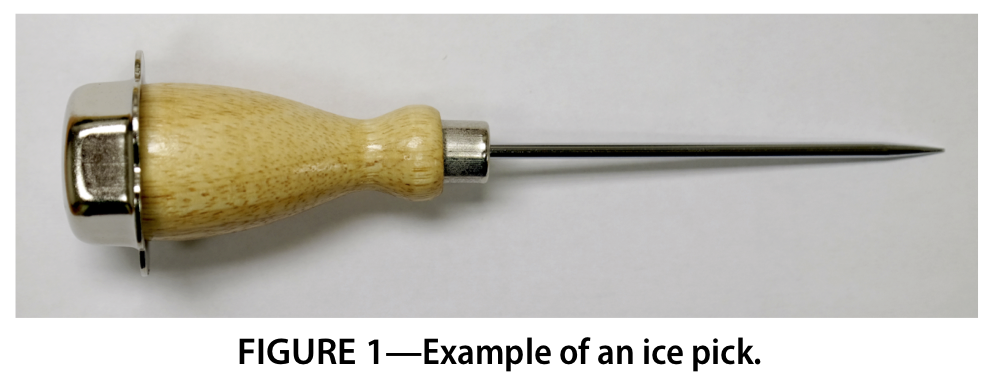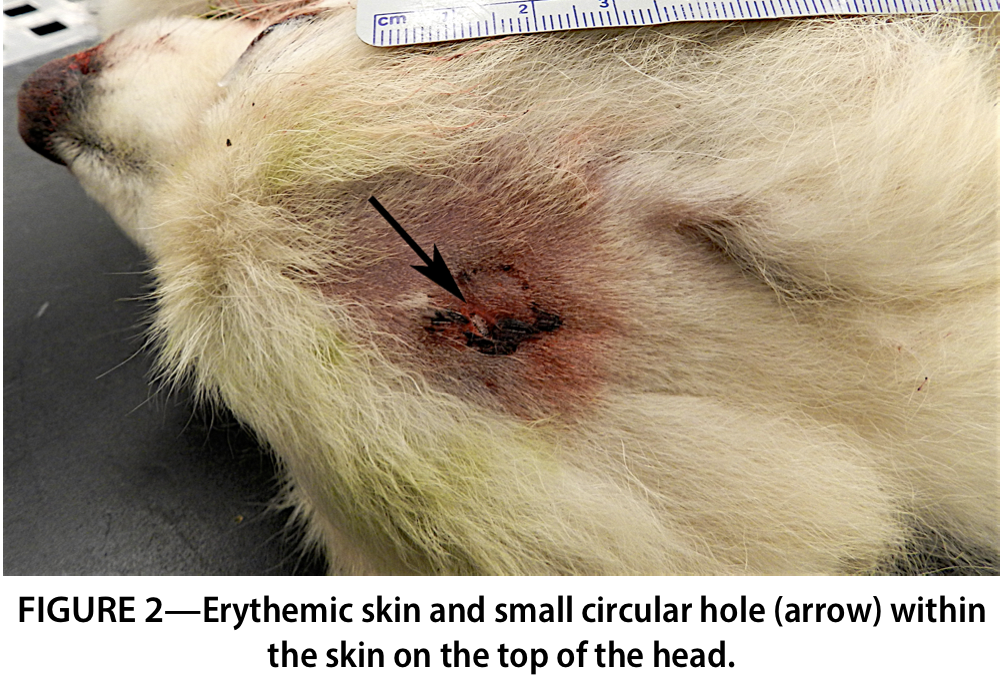![Journal of Veterinary Forensic Sciences [logo]](http://jvfs.net/public/journals/1/pageHeaderLogoImage_en_US.png)
DOI: 10.32473/jvfs.v1i2.128536
Intracranial stab wound in a dog
Abstract: Sharp force wounds are not an uncommon cause of death in animal abuse cases. The reported case is of an adult dog that was stabbed in the head and had evidence of blunt force trauma. The stab wound was small and circular. The findings strongly support the use of an ice pick to cause the injury and support the need to be aware of unusual causes of sharp force trauma.
Keywords: veterinary forensic sciences, pathology, sharp force trauma, stabbing, ice pick, dog, canine
Injuries produced by sharp or pointed objects are collectively known as sharp force injuries. There are four subtypes of sharp force injuries: incised wounds, stab wounds, chop wounds, and therapeutic (or diagnostic) wounds (de Siqueira et al. 2016). Incised wounds are characterized by the length of the wound exceeding the depth of the wound, whereas, stab wounds have a depth that exceeds the length of the wound. Chop wounds appear similar to an incised wound and can produce more crush injury than other types of sharp force trauma. Intermediate types of injuries can be observed, such as a dull-edged chopping weapon that causes more crush injury than incised injury (DiMaio and Dana 2006). Therapeutic wounds are the result of medical intervention.
Stab wounds are a frequent cause of death in homicide cases (Hunt and Cowling 1991; Scolan et al. 2004; Begum et al. 2014). Similarly, stab wounds are encountered as a cause of death in animal abuse cases (Stern and Sula 2018). The extent of the external injury may not correlate with the seriousness or lethality of the internal damage to vital organs (Smith-Blackmore and Robinson 2018). Stabs wounds are low-velocity injuries and damage often restricted to the tract of the wound. In contrast, projectile injuries are high-velocity injuries and can cause massive tissue damage (Munro and Munro 2008). Wounding capacity is determined by kinetic energy, where kinetic energy (KE) is equal to one half times the object’s mass (m) multiplied by velocity squared (v2); KE = ½mv2. Although not an exhaustive list, weapons that are used in stabbings include knives, screwdrivers, scissors, forks, arrows, garden shears, and broken bottles. There is limited information in the literature regarding the postmortem findings of some unusual items used to stab animals, such as an ice pick or awl. Both an ice pick and awl are pointed tools (Figure 1), but an ice pick is traditionally used to break ice, whereas an awl is used to punch small holes in leather and wood. There are several reports of ice picks as weapons that cause stab wounds in the veterinary forensic literature, but descriptions of the injuries are lacking (Munro and Munro 2008, Merck 2007). This case report describes the findings of a dog that had been stabbed with an ice pick.

Case Report
A deceased, 6-year-old, castrated male, Pomeranian dog was presented to the referring veterinarian for necropsy examination. The case history was limited. Reportedly, the dog either slipped out of a door or had been run over by an automobile. The referring veterinarian identified a palpable skull fracture, blood in the mouth, and a small hole on the top of the head. Clinical findings were suspicious for a stab wound or projectile trauma. Radiographic evaluation of the skull revealed multiple skull fractures; no projectile was observed.
At forensic necropsy, the skin on the top of the head was erythemic, with a small amount of clotted blood adhered to the skin. A single, 2-mm-diameter, circular hole with sharp margins was identified on the skin (Figure 2). The skin from the head was removed. The subcutis surrounding the hole was hemorrhagic and edematous. There was a single circular hole within the parietal bone, and there were multiple comminuted fractures of surrounding skull bones, including the frontal, parietal, lacrimal, maxillary, nasal, palatine, sphenoid, occipital, and ethmoid bones. Cerebral brain matter exuded between the fractures of the frontal and parietal bones. Much of the cerebrum was macerated, and there was hemorrhage within the cranial vault. A tract extended from the opening in the skin into the cranial vault, terminating at the nasopharynx. There was clotted blood within the lumen of the larynx, trachea, and main stem bronchi. Two sets of linear rib fractures were present on the left side of the thorax: the body of ribs five through eight and the dorsal aspect of ribs nine through eleven.

Histologic examination was performed. Extravasated erythrocytes were observed within the brain and major airways, without evidence of erythrophagia or erythrocyte breakdown products (hemosiderin, hematoidin). There was no evidence of healing associated with the ribs fractures.
The forensic necropsy findings were consistent with sharp force trauma (stab wound) to the head as well as blunt force trauma to the head and thorax. Given the small intracranial hole, the stab wound was suspected to be caused by a small, slender object, such as an ice pick or screwdriver. Blunt force trauma, including a crush injury to the head, also was suspected.
Discussion
Stab wounds, caused by various sharp instruments, have a depth that is greater than the length. In contrast to humans, it may be challenging to observe evidence (such as contusions, perforations, instrument marks) of sharp force trauma in non-human animals because of the haircoat (de Siqueira et al. 2016). Wound morphology can be useful in differentiating blunt force from sharp force trauma (Table 1). Lacerations caused by blunt force trauma show tissue bridging and ragged edges (Reisman 2018), whereas injuries due to sharp force trauma often have linear or angular edges (de Siqueira et al. 2016).

In this case, there was a combination of sharp force trauma to the head, consistent with a stab wound, and blunt force trauma to the head and chest. The stab wound created a small, circular opening that led into a tract that penetrated the cranial vault and terminated within the nasopharynx. There was evidence that the animal bled into the airways and aspirated the blood. The observation of aspirated blood is of forensic significance as it provides information as to whether the injury occurred antemortem or postmortem (Scaparra et al. 2016). Aspiration of blood, accepted as a sign of vitality, supports the fact that this dog was alive when the injury occurred. The absence of erythrophagia or erythrocyte breakdown products observed microscopically within the areas of hemorrhage is consistent with acute hemorrhage.
Blunt force injuries include multiple skull fractures and two sets of rib fractures. The lack of macroscopic or microscopic evidence of healing indicates that the fractures are acute. Although unilateral ribs fractures are reported in cases of motor vehicle trauma, in totality, the observed pathologic findings are inconsistent with the reported history of the dog being hit by a car or slipping out of a door.
A projectile head wound was unlikely due to the lack of a skin abrasion rim or an exit wound. Furthermore, a projectile was not identified during the radiographic examination or forensic necropsy examination. Further scene investigation at the property in question resulted in the identification of an ice pick covered with red fluid. No testing of the red fluid was performed.
The exact shape of a penetrating object rarely can be deduced from the shape of the skin wound (Munro and Munro 2007). Occasionally, marks are observed that are characteristic of particular weapons. For example, with considerable stabbing force and a fully inserted knife, a mark from the blade guard of the knife may be manifested on the skin (de Siqueira et al. 2016). Serrated knives can leave linear and parallel scratches on the skin; these findings can help distinguish between serrated and non-serrated knives. Wounds produced by forks may be observed as groups of two to six wounds with regular distances between the wounds caused by each tine (Stern and Sula 2018). Arrows and bullets can have a similar appearance, but particular characteristics can facilitate differentiation. Wounds from arrowheads will vary from circular to X-shaped lesions. Arrowheads will slice tissue when forming a tract, whereas a bullet will leave an abrasion rim (de Siqueira et al. 2016). Ice picks and screwdrivers will result in similar lesions and will appear as small and round or slit-like lesions. A Philips head screwdriver will create an X-shaped and circular wound. According to one author, ice pick wounds are less common because they are no longer commonly used in households (Merck 2007).
In cases of sharp force trauma, it is helpful to obtain a complete history of the circumstances of the event. Useful information might include items found at the scene or recovered during the investigation that could have been used as a weapon, as well as information obtained from witness statements. Bloodstain pattern analysis at the scene and examination of suspected weapons for blood and DNA also can be of value for the investigation.
Veterinary pathologists will occasionally be presented with cases involving stab wounds from unusual weapons. This case report highlights the need to be aware of unusual causes of sharp force trauma. Additionally, consultation with crime scene investigators can facilitate the identification of possible weapon(s) from the crime scene.
Disclosures
This research did not receive any specific grant from funding agencies in the public, commercial, or not-for-profit sectors.
References
- Begum A, Huq M, Begum M, Alam A, Akhter G, Tamsin T. 2014. A case report on stab injury. Delta Med Col J. 2(1):36–8. doi:10.3329/dmcj.v2i1.17795.
- de Siqueira A, Cuevas SEC, Salvagni FA, Maiorka PC. 2016. Forensic veterinary pathology: sharp injuries in animals. Vet Pathol. 53(5):979–87. doi:10.1177/0300985816655850.
- Hunt AC, Cowling RJ. 1991. Murder by stabbing. Forensic Sci Int. 52(1):107–12. doi:10.1016/0379-0738(91)90102-o.
- James SH, Kish PE, Sutton TP. 2005. Impact spatter mechanisms. In: James SH, Kish PE, Sutton TP, editors. Principles of bloodstain pattern analysis: theory and practice. Boca Raton (FL): CRC Press. p. 119–30.
- Merck MD. 2007. Patterns of non-accidental injury: penetrating injuries. In: Merck MD, editor. Veterinary forensics: animal cruelty investigations. Ames (IA): Blackwell Publishing. p. 101–14.
- Munro R, Munro HMC. 2008. Wounds and injuries. In: Munro R, Munro HMC, editors. Animal abuse and unlawful killing: forensic veterinary pathology. Philadelphia (PA): Saunders. p. 30–47. doi:10.1016/B978-0-7020-2878-6.X5001-6.
- Reisman R. 2018. Blunt force trauma. In: Brooks JW, editor. Veterinary forensic pathology. Vol. 1. Cham (Switzerland): Springer. p. 65–94. doi:10.1007/978-3-319-67172-7_5.
- Scaparra E, Peschel O, Kirchhoff C, Reiser M, Kirchhoff SM. 2016. Detection of blood aspiration in deadly head gunshots comparing postmortem computed tomography (PMCT) and autopsy. Eur J Med Res. 21:43. doi:10.1186/s40001-016-0237-6.
- Scolan V, Telmon N, Blanc A, Allery JP, Charlet D, Rouge D. 2004. Homicide-suicide by stabbing study over 10 years in the Toulouse region. Am J Forensic Med Pathol. 25(1):33–6. doi:10.1097/01.paf.0000113816.09035.01.
- Smith-Blackmore M, Robinson N. 2018. Sharp force trauma. In: Brooks JW, editor. Veterinary forensic pathology. Vol. 1. Cham (Switzerland): Springer. p. 95–106. doi:10.1007/978-3-319-67172-7_6.
- Stern AW, Sula M. 2018. The forensic necropsy. In: Rogers ER, Stern AW, editors. Veterinary forensics: investigation, evidence collection, and expert testimony. Boca Raton (FL): CRC Press. p. 187–223.